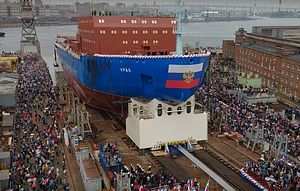Russia has launched the third and final Project 22220 LK-60YA-class nuclear-powered icebreaker at the Baltic Shipyard in Saint Petersburg, Russia on May 25.
“Today we are floating the third ship, or the second serial one of Project 22220 – the Ural. They are the ships from [a] new generation icebreakers (…) that we pin our hopes on in exploration of the Northern Sea Route. It is a principally new ship,” Russian Deputy Prime Minister Yuri Borisov was quoted as saying at the ceremony by Tass news agency.
The Ural was laid down at the Baltic Shipyard, part of the United Shipbuilding Corporation (USC), in July 2016. The ship is expected to be commissioned in 2021. Its sister ships Arktika and Sibir were laid down in 2013 and 2015 respectively and will be commissioned in June 2019 and November 2020.
The ships will be operated by Atomflot, the Russian state-owned company that maintains the world’s only fleet of nuclear-powered icebreakers.
With a length of 173 meters and a width of 34 meters, the 33,000-ton class of icebreakers is the largest of its kind ever constructed. According to Baltic Shipyards Director General Alexei Kadilov, the Ural, in comparison to its two predecessors features a more powerful nuclear reactor and a new electric propulsion system.
“[T]he most important thing is a new turbine which will provide 40-year operation for the icebreaker,” Kadilov was quoted as saying. Each vessel is equipped with a RITM-200 nuclear propulsion plant, which comprises two reactors of 175 megawatt enabling a top speed of 22 knots (41 kilometers per hour).
The main task for the Project 22220 icebreakers will be to clear passages for ship traffic on the Northern Sea route, which runs along the Russian Arctic coast from the Kara Sea to the Bering Strait. Cargo traffic along this route may reach up to 30 million tons per year in the coming years. Russia also expects an uptick in the transportation of hydrocarbons from the Yamal and Gydan peninsulas to the Asia Pacific region.
Russia’s current icebreaker fleet consists of 40 vessels with 11 new ships planned or under construction. Out of the 40, around 27 are ocean-going icebreakers, some of which are nuclear-powered. The Russian government has also plans to build two more Project 22220 icebreakers in addition to the three currently under construction.
In 20117, the Russian Ministry of Defense commissioned the 6,000-ton Project 21180 diesel-electric icebreaker Ilya Muromets, the first icebreaker built for the Russian Navy in forty years. Russia has also been working on armed Project 23550 Ice-class patrol ships.
The 7,000-ton Ice-class Ivan Papanin, laid down in 2017, will reportedly be armed with a 76-millimeter AK-176MA naval gun in a turret and carry up to eight containerized 3M-54 Kalibr supersonic anti-ship cruise missiles.
































